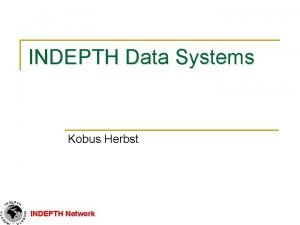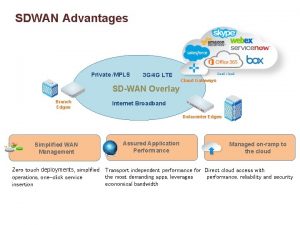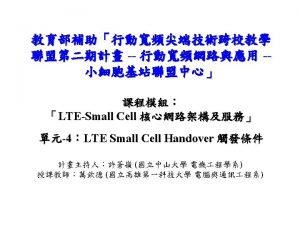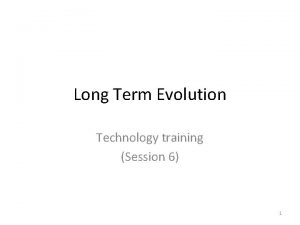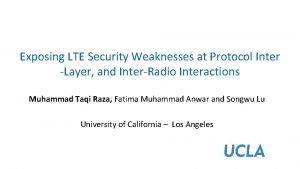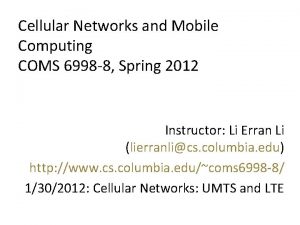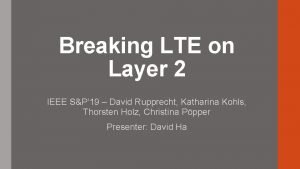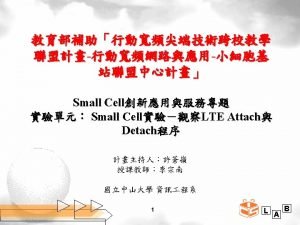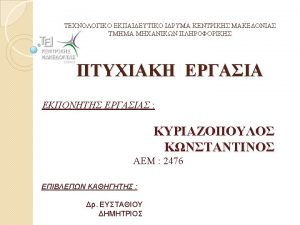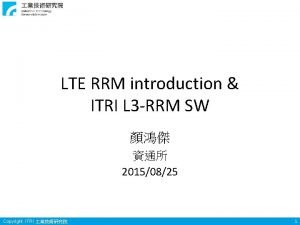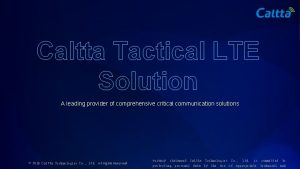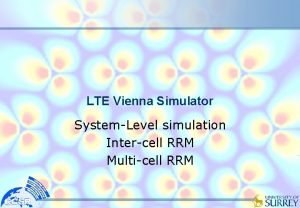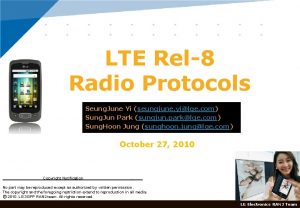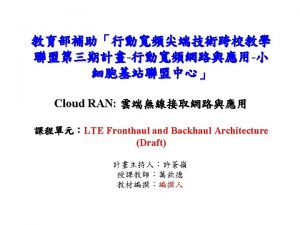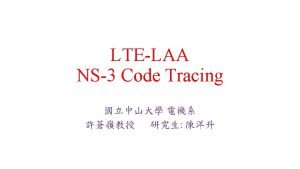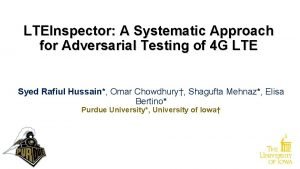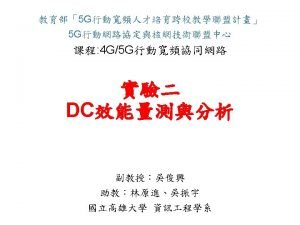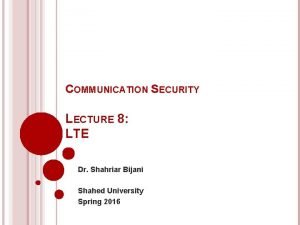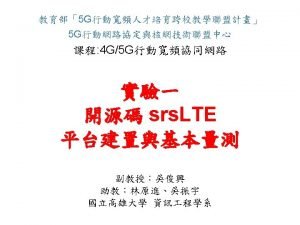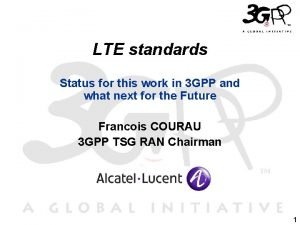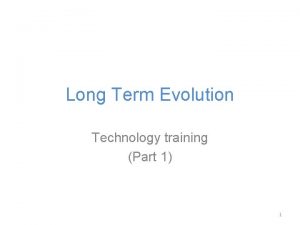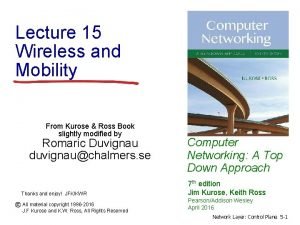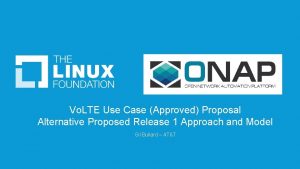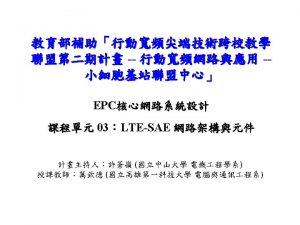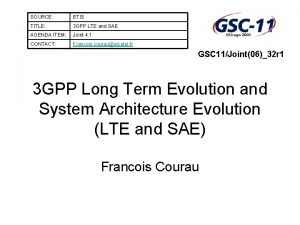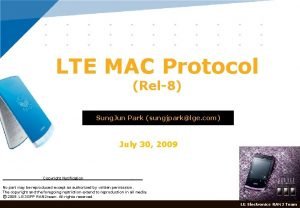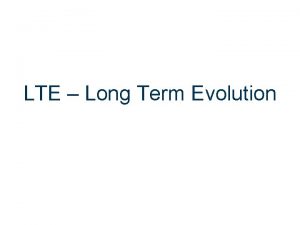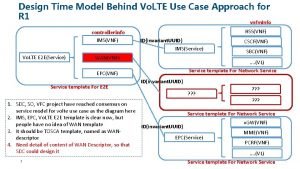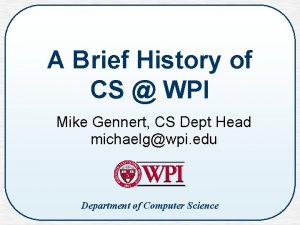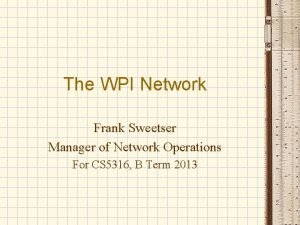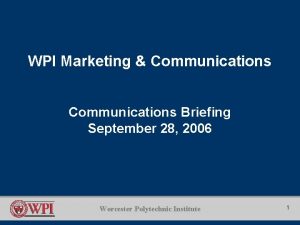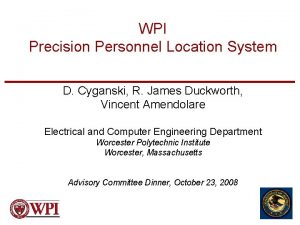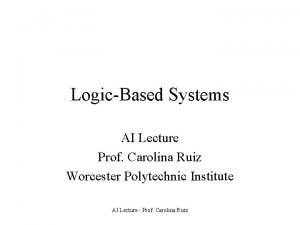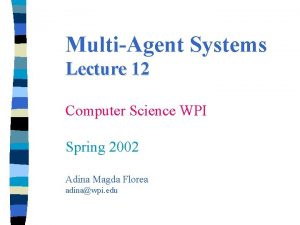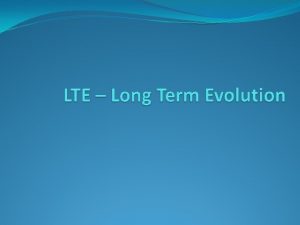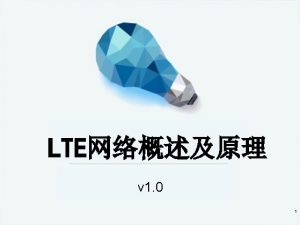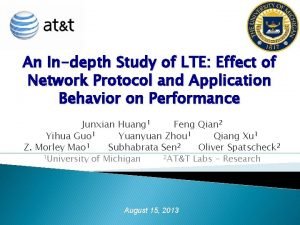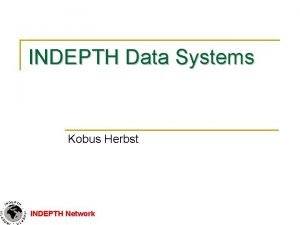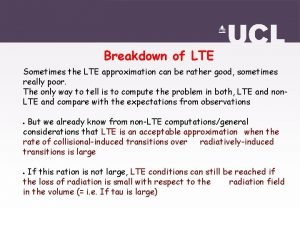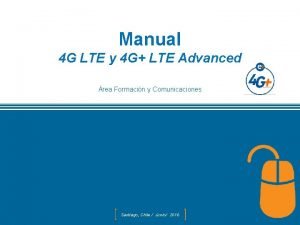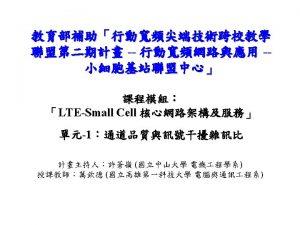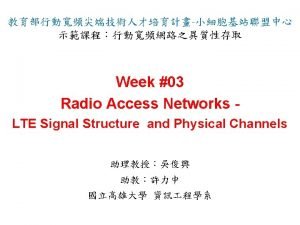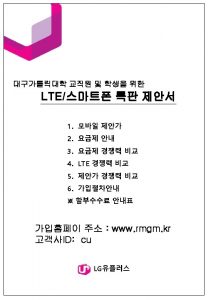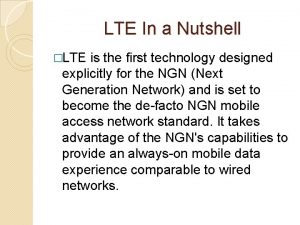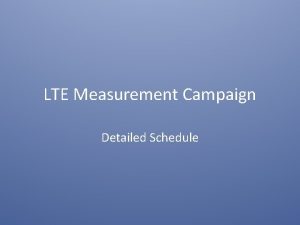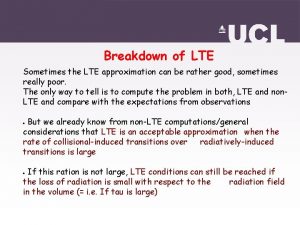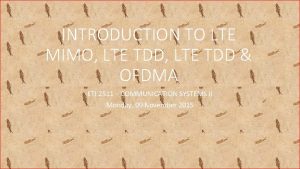WPI An Indepth Study of LTE Effect of















































- Slides: 47

WPI An In-depth Study of LTE: Effect of Network Protocol and Application Behavior on Performance Authors: Junxian Huang, Feng Qian, Yihua Guo, Yuanyuan Zhou, Qiang Xu, Z. Morley Mao, Subhabrata Sen, Oliver Spatscheck CS 577 Brett Levasseur 10/29/2013

Outline • • WPI Introduction LTE Data And Local Testbed LTE Network Characteristics Abnormal TCP Behavior Bandwidth Estimation Network Applications in LTE Conclusions Questions 10/29/2013 2

Introduction WPI • Previously observed LTE network characteristics – Higher bandwidths – Lower RTT – TCP underutilizes links • This work examines – Measurements from real LTE network – TCP bandwidth estimation algorithm – Power management 10/29/2013 3

LTE Network WPI • UE – User Equipment • RAN – Radio Access Network • CN – Core Network • Monitor – Author’s data collection point • PEP – Performance Enhancing Proxy 10/29/2013 4

LTE Network • PEP – Not part of normal CN WPI Internet • Intercepts TCP traffic on ports 80 and 8080 • Splits end to end TCP connection to two – UE to PEP – PEP to server • Performs compression and caching 11/10/2020 HSS PGW MME SGW [Dahlman] RAN 5

LTE Data WPI • Covered 22 e. NBs in a US city • Collection from 10/12/2012 - 10/22/2012 • Collected – IP and transport headers – 64 bit timestamps per packet – HTTP headers – 3. 8 billion packets – 2. 9 TB of traffic (324 GB of headers) 10/29/2013 6

Local Test Bed WPI • UE – Samsung Galaxy S III – Android 4. 0. 4 / Linux Kernel 3. 0. 8 • Server – 2 GB RAM / 2. 4 GHz Intel Core 2 CPU – Ubuntu 12. 04 / Linux Kernel 3. 2. 0 -36 -generic – TCP CUBIC • Measured TCP throughput and RTT • Used two different LTE networks 10/29/2013 7

Outline • • WPI Introduction LTE Data And Local Testbed LTE Network Characteristics Abnormal TCP Behavior Bandwidth Estimation Network Applications in LTE Conclusions Questions 10/29/2013 8

Measurements WPI • Majority of traffic is TCP • Majority of the remainder is UDP TCP Flows (95. 3 %) TCP Bytes (97. 2%) 10/29/2013 HTTP (80/8080) 50. 1% HTTPS (443) 42. 1% HTTP (80/8080) 76. 6% HTTPS (443) 14. 8% 9

TCP Flow Size 11/10/2020 WPI 10

TCP Flow Size WPI 90%, less than 2. 9 KB 10. 9% have no uplink UL Flows Top 0. 1% (by payload) account for 63. 9% of total bytes 73. 6% of the top flows are images 90%, less than 35. 9 KB 11. 3% have no downlink DL Flows Top 0. 6% (by payload) account for 61. 7% of total bytes Top 5% (by payload size) Payload >= 85. 9 KB 80. 3% use HTTP 74. 4% video or audio 11/10/2020 11

TCP Flow Duration 11/10/2020 WPI 12

TCP Flow Duration 11/10/2020 Flows Duration 48. 1% < 5 seconds 6. 8% >= 3 minutes 2. 8% >= 10 minutes Flows Termination 86. 2% TCP FIN 5. 4% TCP RESET 8. 5% TCP SYN (did not connect properly) WPI 13

Tail Time WPI 10 seconds between last transmission and the UE radio being turned off 11/10/2020 14

TCP Flow Rate WPI Better flow rate • Larger flows send faster than smaller flows • Flow duration and rate are more negatively correlated than on Internet backbone 11/10/2020 15

TCP Concurrency WPI • 72. 1% of the time there is only one active TCP flow • Possibly higher for smartphones 11/10/2020 16

RTT WPI Better RTT C-M = Client to monitor M-P = Monitor to PEP M-S = Monitor to server C-S = Client to server RTT to M-S > C-M • RTT Monitor to server > than client to monitor • Indicates wireless link is not largest delay factor 11/10/2020 17

LTE Promotion Delay WPI • Time to turn radio on • G(TSb - TSa) = RTT seen by UE • G – Inverse ticking frequency of UE’s clock Percentile Promotion Delay 25% 319 ms 50% 435 ms 75% 558 ms 11/10/2020 18

Queuing Delay 11/10/2020 WPI 19

Queuing Delay WPI • 10% of large flows have > 200 KB in-flight • Leads to – Queue delay – Longer RTT – Created by long flows but impacts short flows 11/10/2020 20

TCP Retransmission Rate WPI • 38. 1% of flows have no retransmission • 0. 06% is the median of flows with retransmission • Physical/MAC layer retransmission reduced transport layer retransmission • Study does not look at LTE RLC layer retransmissions 10/29/2013 21

Measurement History WPI • LTE outperforms 3 G, Wi. MAX and Wi. Fi • 4 GTest LTE is higher than measurements – Possibly due to rate limiting at remote server 11/10/2020 22

Outline • • WPI Introduction LTE Data And Local Testbed LTE Network Characteristics Abnormal TCP Behavior Bandwidth Estimation Network Applications in LTE Conclusions Questions 10/29/2013 23

Duplicate ACKs WPI • Medians – 17 Dup ACKs – 2 out of order packets • Over 29% of flows have > 100 Dup ACKs • Ratio Dup ACK / out of order – 24. 7% of flows over 25 – Some up to 5, 000 – 1 out of order packet can cause many Dup ACKs 11/10/2020 24

Undesired Slow Start WPI • Undesired Slow Start – Large RTT triggers RTO • Author’s measure undesired slow start with • Where is average downlink throughput from t 1 ms to t 2 ms after last Dup ACK • Rss > 1. 5 in slow start – 20. 1% of large flows have >= 1 lost packet – 12. 3% of all large flows have >= 1 lost packet 10/29/2013 25

Undesired Slow Start WPI Rss = 3. 5 Rss = 1. 0 10/29/2013 26

Mitigate Undesired Slow Start WPI • Update RTO from duplicate ACKs with SACK – Take difference between SACK window of two consecutive duplicate ACKs – 82. 3% of flows used SACK in dataset – < 1% of flows had packet reordering • Update RTO from duplicate ACKs without SACK – Assume duplicate ACKs in response to data packets in order • Prevent > 95% of observed undesired slow starts 10/29/2013 27

Outline • • WPI Introduction LTE Data And Local Testbed LTE Network Characteristics Abnormal TCP Behavior Bandwidth Estimation Network Applications in LTE Conclusions Questions 10/29/2013 28

TCP Transmission Rate WPI Sending Rate from Monitor Receive Rate at UE 10/29/2013 29

TCP Timestamps WPI • Replace t 1 and t 5 with t 2 and t 6 • t 2 and t 6 originate at UE • Replace t 2 and t 6 with TCP Timestamps • Infer G 11/10/2020 30

Estimation Accuracy WPI • For accurate G t 7 – t 3 > • Error rate of G drops as grows • At = 3 seconds error rate < 0. 1% 11/10/2020 31

Estimation Accuracy Flows G 5. 9% NA 57. 3% 1 ms/tick 36. 4% 10 ms/tick 0. 4% 100 ms/tick WPI • With = 3 seconds the error rate of inferred G < 0. 1% for the majority of flows • If G is unknown it is estimated from its formula 10/29/2013 32

Estimation Summary WPI • G is known or inferred • Calculate Rsnd • If Rsnd >= C AND packets in order AND no duplicates AND last packet is not delayed ACK – Rrcv calculated • If C too small – underestimate • If C too large – not enough samples • C = 30 Mbps 10/29/2013 33

Validation WPI • Compare server side estimate and UE trace • 1 sec sample window average error rate is 7. 9% • 0. 1 sec sample window average error rate has higher variation 11/10/2020 34

Validation WPI • Actual throughput is UE perceived throughput • Used 1 sec sample window • Actual throughput varies around 10 Mbps • Error varies by +- 1 Mbps 11/10/2020 35

Large Flow Utilization WPI • Median ratio 19. 8% • 71. 3% of large flows < 50% utilization • 6. 4% use more bandwidth than estimated • Average ratio 34. 6% • Low utilization, flows last longer – Higher radio usage 11/10/2020 36

LTE Bandwidth Variation WPI • Two large flows – Two different users – Two different times • Bandwidth varies over time – Condition of the wireless link – Movement – Resource scheduling 11/10/2020 37

RTT & Throughput WPI • Experiments with modifiable RTT – Used iptables to redirect packets to scheduler – Scheduler changes available bandwidth similar to observed LTE – Scheduler injects delays to impact RTT • Under small RTT TCP utilizes 95% of the bandwidth • RTT > 400 ms utilization drops below 50% 10/29/2013 38

Outline • • WPI Introduction LTE Data And Local Testbed LTE Network Characteristics Abnormal TCP Behavior Bandwidth Estimation Network Applications in LTE Conclusions Questions 10/29/2013 39

HTTP Characterization HTTP Content % of traffic Video 37. 8% Images 19. 5% Text 11. 8% Zip 8. 3% Audio 6. 5% Other 5. 6% Unknown 10. 5% WPI • 12. 9% of video content is octet-streams generated mostly by video players 10/29/2013 40

TCP Receive Window Shazam app on i. OS 30 s, 1 MB audio 0 s – 2 s 3 Mbps Recv window full 2 s – 9 s < 300 Kbps Download could have been done in 2. 5 s • Connection not closed until 30 s • • • 11/10/2020 WPI If receive window did not fill up 41

TCP Receive Window WPI • Receive Window around 131, 712 +- 600 bytes – True for > 90% of i. OS, Android and Windows Phone flows • Applications not reading from receive buffer quickly enough • 52. 6% of downlink TCP flows experience full receive window – 91. 2% of these bottleneck happens in initial 10% of the flow duration 10/29/2013 42

Application Design WPI • Netflix on i. OS • Multiple HTTP byterange requests • Many short HTTP responses – < 1 s – 1 – 4 MB • Periodic requests leaves radio idle 11/10/2020 43

Discussion WPI • Manufactures reduce TCP receive window – Decreases buffer bloat – Underutilizes network • Use application buffers – Relieves TCP buffers – Allows radio interface to close sooner • Increase amount downloaded per request, decrease number of requests 10/29/2013 44

Conclusions WPI • Not updating RTT from Dup ACKs causes performance issues with single packet loss • Bandwidth estimation algorithm – 71. 3% of large flows have < 50% utilization – High variation of network bandwidth – cwnd too slow to adjust • TCP receive window throttles 52. 6% of downlink flows • App design underutilizes bandwidth 10/1/2013 45

Questions 10/1/2013 WPI 46

References WPI • Huan J. et all, An In-depth Study of LTE: Effect of Network Protocol and Application Behavior on Performance. SIGCOMM 2013. • Dahlman E. et all, 4 G LTE/LTE-Advanced for Mobile Broadband. Academic Press, 2011. 10/29/2013 47
 In-depth comprehension
In-depth comprehension Indepth data
Indepth data Advantages and disadvantages of mpls
Advantages and disadvantages of mpls Lte handover events
Lte handover events Transmit diversity in lte
Transmit diversity in lte Paging in lte
Paging in lte Frame structure in lte
Frame structure in lte Breaking lte on layer two
Breaking lte on layer two Gpp network
Gpp network Lte τεστ προσομοιωσης
Lte τεστ προσομοιωσης Vo ltez
Vo ltez Qoffset
Qoffset Tactical lte
Tactical lte Lte
Lte Lte nas procedures
Lte nas procedures C-ran
C-ran Ns3 tutorialspoint
Ns3 tutorialspoint Lte inspecteur
Lte inspecteur V lte symbol on phone
V lte symbol on phone Gpp lte means
Gpp lte means 172 0 0 1
172 0 0 1 Gpp lte meaning
Gpp lte meaning Physical layer in lte
Physical layer in lte Lte network architecture
Lte network architecture V0 lte
V0 lte V0 lte
V0 lte Sae epc
Sae epc Gpp lte
Gpp lte Sung jun park
Sung jun park Dtch lte
Dtch lte V0 lte
V0 lte Wpi cashnet
Wpi cashnet Wpi ece department
Wpi ece department Wpi mqp database
Wpi mqp database Wpi wifi setup
Wpi wifi setup Techsync wpi
Techsync wpi Imgd wpi
Imgd wpi Wpi powerpoint template
Wpi powerpoint template Carolina ruiz wpi
Carolina ruiz wpi Wpi ece flowchart
Wpi ece flowchart Boosting in data mining
Boosting in data mining Carolina ruiz wpi
Carolina ruiz wpi Asaad hussain
Asaad hussain Wpi cs
Wpi cs Wpi
Wpi Carolina ruiz x
Carolina ruiz x Phase noise
Phase noise Wpi merchant services
Wpi merchant services

